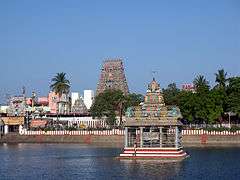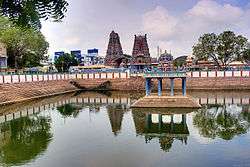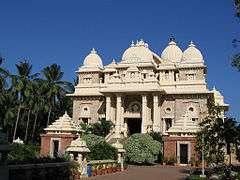Religion in Chennai
Chennai is religiously cosmopolitan, with its denizens following various religions, chief among them being Hinduism, Islam, Christianity, Sikhism, Jainism, Buddhism, and Zoroastrianism. Chennai, along with Mumbai, Delhi and Kolkata, is one of the few Indian cities that are home to a diverse population of ethno-religious communities.[2] With the majority of the people in India following Hinduism, Chennai, like other Indian cities, is home to more Hindus than any other religion. Chennai has centres of worship for a multitude of faiths. According to 2001 census, majority of the population are Hindus (81.3 percent), Muslims (9.4 percent), Christians (7.6 percent), Jains (1.1 percent), Sikhs (0.06 percent), and Buddhists (0.04 percent).[3]
| Religions and their adherents (in percentage of total population) | |||||||
|---|---|---|---|---|---|---|---|
| Census | Hindu | Muslim | Christian | Jain | Buddhist | Sikh | Others |
| 1901 | 80.6 | 11.3 | 8.0 | 0.05 | 0.02 | 0 | 0.02 |
| 1911 | 80.2 | 11.4 | 8.1 | 0 | 0 | 0 | 0.35 |
| 1921 | 81.2 | 10.1 | 8.4 | 0.2 | 0.1 | 0 | 0 |
| 1931 | 80.4 | 10.8 | 8.4 | 0.4 | 0.05 | 0 | 0 |
| 1941 | 79.9 | 12.3 | 5.9 | 0 | 0 | 0 | 2.31 |
| 1951 | 81.6 | 9.9 | 7.8 | 0.4 | 0.07 | 0.07 | 0.09 |
| 1961 | 85 | 7.5 | 6.9 | 0.5 | 0.02 | 0.04 | 0.07 |
| 1971 | 84.1 | 8.5 | 6.6 | 0.7 | 0.03 | 0.05 | 0.01 |
| 1981 | 84.4 | 8.1 | 6.4 | 0.7 | 0.1 | 0.04 | 0.06 |
| 1991 | 83.9 | 8.7 | 6.4 | 0.9 | 0.02 | 0.04 | 0.03 |
| 2001 | 81.3 | 9.4 | 7.6 | 1.1 | 0.04 | 0.06 | 0.23 |
Hinduism
Hinduism is the native faith of Chennai. The origin of Hinduism in the city dates back to antiquity. The temple towns of Mylapore, Triplicane, Thiruvottiyur, Saidapet and Thiruvanmiyur, which are now part of Chennai city, had been visited by the Saivite saints called Nayanmars. The saint Vayilar Nayanar was born and brought up in Mylapore. Sambandar gives a physical description of Mylapore in his hymns:
In Mylapore of beautiful groves, The waves creep up to the shore and then dance on it As do the fisherfolk who spear the many fish in the waters, Kapaleeswaram in its plenty celebrates the Thiruvadhirai festival, Is it done for you to miss this excitement, Poompavai? (English translation)
The early dubashes or Indian merchants who worked for the British East India Company were devout Hindus. The Chennakesava Perumal Temple, considered to be the chief Hindu temple of Madraspatnam and first to be built since the founding of the city in 1640, was constructed by the dubash Beri Thimappa in 1646. Chennai is also an important centre of the Ramakrishna Order whose oldest institution the Sri Ramakrishna Math was founded in Chennai in May 1897. According to a 1981 estimate, there were about 600 Hindu temples in Chennai, including the Chennakesava Perumal Temple, Chenna Mallesvarar Temple, Kapaleeswarar Temple, Parthasarathy Temple, Vadapalani Andavar Temple, Ashtalakshmi Kovil, Kalikambal Temple and the Thiruvalluvar Temple.
Islam
Islam is the second largest religion of Chennai accounting for around 9.4 percent of the population according to the 2001 census. An overwhelming majority of Chennai Muslims belong to the Sunni sect although a small Shia minority does exist. Majority of Muslims of Chennai speak Urdu, the rest speak Tamil and other Indian languages.
Christianity

Christianity was introduced in Chennai by the Christian apostle St. Thomas, who is believed to have preached in the city between the years AD 52 and AD 70.[4][5][6] St. Thomas, one of the twelve disciples of Jesus Christ, was martyred in St. Thomas Mount in the southern part of the city and was buried in Mylapore.[7][8] San Thome Basilica, one of the earliest churches in the city, was built in the 16th century by Portuguese explorers, over the supposed tomb of St. Thomas.[9] The city has one of the highest population of Christians among major Indian cities, accounting for 7.6 percent of the city's population.
Sikhism
The earliest arrival of Sikhs in the city is not known officially as there are no records. However, the migration is said to have been consistent before, during, and after the partition of India. As of 2012, there were about 300 Sikh families residing in the city. Sri Guru Nanak Sat Sangh Sabha, established in 1949, is a centre for social, religious and spiritual activities and is a common point for the Sikh families in the city to converge during special occasions and festivals.[10]
Jainism
There are both North-Indian and Tamil Jains in the city, although the former outnumber the latter. There are about 100 Jain temples in the city built by the North Indian Jains, whereas there are only 18 Tamil Jain temples catering to roughly 1,500 Tamil Jain families.[11]
Buddhism
The city's only Buddhist temple, the Sri Lanka Maha Bodhi Centre, is located at Egmore.
Zoroastrianism
Parsis first arrived in the city in 1809 from Coorg when the ruling King's brother sent a deputation to the Governor of Fort St. George to deliver a picture. Hirijibhai Maneckji Kharas was the first Parsi to land in the city, who was accompanied by five other Parsis and two priests who bought land at Royapuram opposite the Catholic Church. By 1900s, the Parsis established themselves well in the city, dealing in cars, cycles, perfumes and dyes. The first Iranis came to Madras around 1900 and soon became known for their Irani cafes and also established or managed theatres. There was no official priest in the community for over 100 years till 1906. There was no place of worship till the Royapuram fire temple was built in 1909.[12] As of 2010, there were about 250 Parsis in Chennai. Many of them live in Royapuram.[13]
Other religious organisations
Theosophy
Chennai is the international base of the Theosophical Society, a spiritual organisation dedicated to the study of world religions and inter-faith dialogue. Since 1882, Chennai has been the headuquarters of the Theosophical Society.[14]
See also
References
- ↑ "Population By Religious Community - Tamil Nadu" (XLS). Office of The Registrar General and Census Commissioner, Ministry of Home Affairs, Government of India. 2011. Retrieved 13 September 2015.
- ↑ "The magic of melting pot called Chennai". The Hindu. 19 December 2011. Retrieved 29 December 2012.
- ↑ "Area and Population" (PDF). Government of Tamil Nadu. pp. 1–3. Retrieved 28 December 2012.
- ↑ The Encyclopedia of Christianity, Volume 5 by Erwin Fahlbusch. Wm. B. Eerdmans Publishing - 2008, Page 285. ISBN 978-0-8028-2417-2.
- ↑ A. E. Medlycott, (1905) "India and the Apostle Thomas"; Gorgias Press LLC; ISBN 1-59333-180-0.
- ↑ Thomas Puthiakunnel, (1973) "Jewish colonies of India paved the way for St. Thomas", The Saint Thomas Christian Encyclopedia of India, ed. George Menachery, Vol. II.
- ↑ "Saint Thomas (Christian Apostle) -- Encyclopedia Britannica". britannica.com. Retrieved 5 September 2014.
- ↑ Farmer, David (2011). The Oxford Dictionary of Saints, Fifth Edition Revised. Oxford University Press. p. 418. ISBN 978-0199596607.
- ↑ "Basilica of the National Shrine of St.Thomas". SanThomeChurch.com. Retrieved 20 February 2010.
- ↑ Sampath, Janani (25 March 2013). "'We call ourselves Tamilian Punjabis'". The New Indian Express. Chennai: Express Publications. Retrieved 30 March 2013.
- ↑ Jain, Mahima (28 December 2013). "Tamil Jain?". The Hindu. Chennai: The Hindu. Retrieved 27 April 2014.
- ↑ "Parsi community celebrates 100 years of fire temple". The Hindu. Chennai: The Hindu. 11 July 2010. Retrieved 24 April 2014.
- ↑ Mathai, Kamini (12 July 2010). "Parsis go all out to celebrate milestone in Chennai". The Times of India. Chennai: The Times Group. Retrieved 24 April 2014.
- ↑ Kirby, W. F. (January 1885). "The Theosophical Society". Time (London) XII (1): 47-55. (London: Swan Sonnenschein). OCLC 228708807. Google Books Search. Retrieved 2011-01-12. Profile by the entomologist and folklorist William Forsell Kirby.




